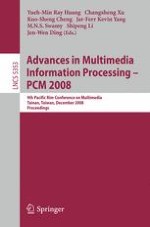Welcome to the proceedings of 9th Pacific-Rim Conference on Multimedia (PCM 2008) held at the National Cheng Kung University, Tainan, Taiwan during Dec- ber 9–13, 2008. The first PCM was held in Sydney in 2000. Since then, it has been held successfully around the Pacific Rim, including Beijing in 2001, Hsinchu in 2002, Singapore in 2003, Tokyo in 2004, Jeju in 2005, Zhejiang in 2006, Hong Kong in 2007 and finally Tainan. PCM is a major annual international conference bringing together researchers, developers, and educators in the field of multimedia from around the world. It covers a wide spectrum of multimedia research, from state-of-the-art theoretical breakthroughs to the practical systems of multimedia analysis and processing. PCM 2008 featured a comprehensive program including tutorials, keynote talks, regular oral presentations, special sessions, and poster sessions. This year, we - cepted 79 papers out of 210 submissions, giving an acceptance rate of 37%. In addition, 39 papers were accepted for poster presentation. The submissions were categorized into five different tracks: multimedia compression, communication and networking, multimedia processing, analysis and retrieval, multimedia databases, systems, and applications, multimedia human–computer interfaces, multimedia security and digital right management, with a total of 210 submissions from 18 countries and regions. Among the five tracks, “multimedia analysis and retrieval” received the most submissions (34% of the submissions). We kindly appreciate the great effort made by the Program Committee members and the additional reviewers in the reviewing of submissions.
